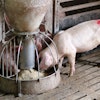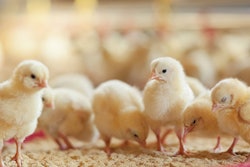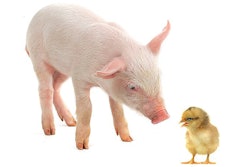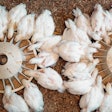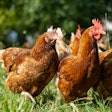
There is rather little new in the science behind phytogenics, also known as botanicals in the U.S., or even as essential oils in their early history as a feed additive. Manufacturers continue to refine their products, making them safer to use, more standard in terms of quality and concentration, and even new components continue to be added into the “mix” to give new functional abilities.
Briefly, it needs to be noted that today phytogenics are used mainly to enhance feed efficiency in broilers. They do that by increasing nutrient digestibility directly, as in the case of capsaisin, or indirectly, as with many compounds that control digesta microflora. Lately, some components have been shown to improve immune system reaction, leading to healthier birds, in general.
Read more: The potential of phytogenic feed additives
The intense discussion over the use of antibiotics as growth-promoting agents in the U.S. that started a few years ago remains alive as products continue to be tested as replacements. As with any additive that controls unpredictable and highly variable digesta microflora, response to commercial phytogenic products remains predictably variable. Thus, broiler producers remain advised to test each product they deem sophisticated enough and suitable for their goals under their own conditions. Nevertheless, there are a number of questions that broiler producers need answered before they can test phytogenics.
- Why do phytogenics work better in broilers than in piglets? It is well-known that the results we have obtained in the last decade or so using phytogenics in weaned piglets are extremely confusing. Not only were products still in the development phase, but weaned piglets are a very unpredictable organism to run any kind of tests with. In contrast, broilers do not suffer from post-weaning trauma, they do not switch abruptly to a diet that is rather offensive for their digestive system, and as such, they produce more even results to any additive. Plus, they have a much shorter digestive tract that is more pliable to external manipulation. Therefore, we can confidently say that phytogenics do not work better in broilers, but that broilers are a more stable organism giving us more results (positive or negative) in a given period of time. This enables a faster screening of any additive.
- What are the differences between the many phytogenic products? Clearly, a generic product designed first for piglets will not inspire much confidence if it is not accompanied with extensive data demonstrating it also works in broilers. But, products differ in more than that, always assuming quality remains high. Each phytogenic product is a mix of individual compounds, correctly termed as “secondary plant metabolites.” Products differ not only in concentration of active ingredients but also in the origin and type of these compounds. Some are natural, others are synthesized, some are extremely volatile, others not so. It is safe to assume that each product is, and must be, unique and cannot be compared to any other product (unless it is a low-cost copy) solely based on price.
- Is volatility a major concern? Indeed, the majority, but not all, of these compounds are very volatile. In fact, this was a major problem with early products — something that led many to classify this additive with so many others that are ineffective. Today, manufacturers understand much better how to confront volatility. Measures include encapsulation (significantly reduced losses) or binding to a very efficient matrix-carrier (markedly reduced volatility). Absolutely no losses are impossible under practical conditions, but in broilers, this is not a major problem as feeds are produced and consumed almost immediately, at least in integrated or large farms, in general.
- What is the expected return on benefit? As always, this depends on the expected performance improvement and cost of each product. In general, there is no dramatic improvement in feed efficiency, but in broilers, even small improvements are significant due to high numbers raised in most farms and the universal low margins in this business. From a number of commercial and scientific trials, a figure of 3 to 5 percent improvement in feed conversion rate can be anticipated in most cases. When the value of this improvement exceeds the cost of the product then we have a positive return on investment that needs to be evaluated against other opportunities. Other production parameters affected by phytogenics can be use of medication or footpad quality, however, the expected return of this improvement is harder to evaluate. Lamentably, in broiler nutrition, there is only a handful of additives that really work, and as such, nutritionists are rather limited in their options.
- Are phytogenics a better investment for early feeds? Any manufacturer would argue that phytogenics (or any additive) work best when fed throughout the life of broilers. In most, but not all, cases this is correct, albeit rather expensive. When it comes to limited resources to spend on additives, one is inclined to spend money on expensive additives in early feeds. Perhaps this is correct in most ingredients and additives as a super pre-starter diet provides life-long benefits. But, in the case of phytogenics, which work by improving feed efficiency, the results are more pronounced in the later grower phase. This is simply because birds consume most of their lifetime feed in the last few weeks before market, and also because feed efficiency tends to get worse with each passing week.
- Do phytogenics work also in layers? Layers are more complicated in terms of nutritional management as they have a production cycle (egg) almost every day, whereas their organism deteriorates with each egg they produce. Thus, feed conversion efficiency also gets worse after a certain period, and phytogenics might offer some alleviation to this issue. One would not be unreasonable to expect a different mix of secondary plant metabolites required in the case of layers compared to broilers. At the moment, this is still a developing area of investigation.
In brief, phytogenics remain a well-established product, despite the renewed and justified interest in the U.S. Manufacturers continue to improve their products, and buyers should insist on buying the most modern products available suited to their specific needs. Even then, testing this (and any) additive under one’s own farm conditions is the ultimate guarantee towards a positive and significant return on investment.

